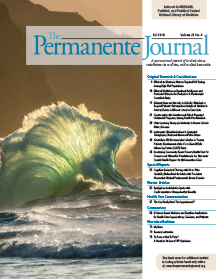Kaiser Permanente’s Department of Research and Evaluation in Southern California is 1 of 42 health systems selected to participate in a PCORI initiative.
Fall 2018 Edition of the Permanente Journal Now Available
 The latest Permanente Journal is now available for download, and includes a variety of peer-reviewed articles and studies on topics from contraception after abortion to urate-lowering therapy for chronic kidney disease.
The latest Permanente Journal is now available for download, and includes a variety of peer-reviewed articles and studies on topics from contraception after abortion to urate-lowering therapy for chronic kidney disease.
This edition also includes a supplement with a special report co-written by Michael Kanter, MD, chief quality officer of The Permanente Federation, on how Kaiser Permanente is looking at social determinants of health in developing treatment plans for patients.
Read more about what’s inside this quarter’s Journal and click on articles of interest below. Or you can download the PDF for the complete edition.
Original Research and Contribution
![]() Effect of an Electronic Alert on Targeted HIV Testing Among High-Risk Populations
Effect of an Electronic Alert on Targeted HIV Testing Among High-Risk Populations
Rulin C Hechter, PhD, MS, MD; Zoe Bider-Canfield, MPH; William Towner, MD
The authors identified 1,800,948 patients who made 2,326,701 health care encounters eligible for HIV testing before implementation (1/08-6/12) and 1,362,479 eligible encounters after implementation (1/13-6/15). The same-day HIV testing rate increased from 36.7 percent to 44.1 percent, a significant increase. The positive test result rate increased from 0.02 percent to 0.04 percent (p < 0.001). During the post-implementation period, fewer HIV-infected patients had a CD4+ cell count below 200 and/or HIV viral load of 10,000 copies/mL or higher at diagnosis.
Effect of Meditation on Emotional Intelligence and Perceived Stress in the Workplace: A Randomized Controlled Study
Laurent Valosek; Janice Link, MA; Paul Mills, PhD; Arthur Konrad, PhD; Maxwell Rainforth, PhD; Sanford Nidich, EdD
Of the central office staff at the San Francisco Unified School District, 96 were randomly assigned to either immediate start of the Transcendental Meditation program or to a wait-list control group. There was a significant increase in emotional intelligence total score and a significant decrease in perceived stress in Transcendental Meditation participants (compared with controls), and also a significant increase in general mood, stress management, adaptability, intrapersonal awareness, and reality testing composite scales for emotional intelligence.
Different Harm and Mortality in Critically Ill Medical vs Surgical Patients: Retrospective Analysis of Variation in Adverse Events in Different Intensive Care Units
Ko Un Park, MD; Michael Eichenhorn, MD; Bruno DiGiovine, MD; Jennifer Ritz, RN; Jack Jordan; Ilan Rubinfeld, MD, MBA
Three years of data were accessed from the Henry Ford Health System No Harm Campaign in Detroit, MI. Harm was defined as any unintended physical injury resulting from medical care. The study included 19,844 patients (7483 were surgical). The overall mortality was 7.8 percent (n = 1554). More surgical patients experienced harm than did nonsurgical patients (2923 [39.1 percent] vs 2798 [22.6 percent]). Surgical patients were less likely to die (6.2 percent vs 8.8 percent). Surgical patients were more likely to experience harm (procedure related) but had lower mortalities vs other harmed patients.
![]() Contraception after Abortion and Risk of Repeated Unintended Pregnancy among Health Plan Members
Contraception after Abortion and Risk of Repeated Unintended Pregnancy among Health Plan Members
Debbie Postlethwaite, RNP, MPH; Justine Lee, MD; Maqdooda Merchant, MSc, MA; Amy Alabaster, MPH; Tina Raine-Bennett, MD, MPH
A retrospective cohort study was conducted using a randomized proportional sample of women aged 15 to 44 years having abortions in Kaiser Permanente Northern California (KPNC). Women having abortions from contracted facilities were significantly less likely to initiate long-acting reversible contraception (LARC). Women initiating short-acting or no contraception were significantly more likely to have an unintended pregnancy within 12 months of the abortion than those initiating LARC. KPNC now provides reimbursement for LARC in all outside abortion contracts, internalized more abortions in KPNC facilities, and strengthened clinical recommendations for immediate, elective postabortion contraception, especially LARC.
![]() Urate-Lowering Therapy in Moderate to Severe Chronic Kidney Disease
Urate-Lowering Therapy in Moderate to Severe Chronic Kidney Disease
Gerald Levy, MD, MBA; Jiaxiao M Shi, PhD; T Craig Cheetham, PharmD, MS; Nazia Rashid, PharmD, MS
Hyperuricemia is an independent risk factor for progression of kidney disease. This was a retrospective epidemiologic cohort study conducted over 8 years of 12,751 patients; 2690 patients received urate-lowering therapy (ULT) during follow-up and 10,061 did not. Patients who achieve an American College of Rheumatology target serum Uric Acid below 6 mg/dL during ULT have higher rates of estimated glomular filtration rate improvement, especially in chronic kidney disease Stages 2 and 3.
Inadequate Clinical Indications in Computed Tomography Chest and Abdomen/Pelvis Scans
Alyssa Finger; Mark Harris; Emily Nishimura; Hyo-Chun Yoon, MD, PhD
The authors reviewed 400 computed tomography (CT) chest scans and 400 CT abdomen/pelvis scans (1/16 – 3/16). Of the CT chest indications, 14.0 percent were complete (a primary symptom, location and duration, and suspected etiology), 4.3 percent had none of the components, and 48.8 percent had a principal etiology. Of the CT abdomen/pelvis indications, 23.5 percent were complete and 3.3 percent had none of the components, and 43.3 percent had a principal etiology. Only 5.8 percent of the CT chest studies and 8.8 percent of the CT abdomen/pelvis studies had information considered sufficient for the radiologist.
Clostridium Difficile-Associated Infection in Trauma Patients: Development of the Clostridium Difficile Influencing Factors (CDIF) Score
Efstathios Karamanos, MD; Arielle Hodari Gupta, MD; Cletus Nor Stanton, MD; Adhnan Mohamed, MD; Joe H Patton, MD, FACS; Nathan Schmoekel, DO
All trauma patients admitted to a Level I trauma center from 2001 to 2014 were retrospectively reviewed. Of 11,016 patients identified, 50 patients with Clostricium difficile-associated infection (CDAI) were matched to 150 patients without CDAI. Patients in whom CDAI developed had significantly higher mortality (12 percent vs 4 percent), need for mechanical ventilation (57 percent vs 23 percent), and mean hospital length of stay (15.3 days vs 2.1). In trauma patients, CDAI results in significant morbidity and mortality. The C difficile influencing factor score is a useful tool in identifying patients at increased risk of CDAI.
Developing Community-Based Primary Health Care for Complex and Vulnerable Populations in the Vancouver Coastal Health Region: HealthConnection Clinic
Ali Rafik Shukor, MBiotech, MSc; Sandra Edelman, MA; Dean Brown, MD; Cheryl Rivard, MA
Designing, delivering, and evaluating high-performing primary health care services for complex and vulnerable sub-populations are challenging endeavors. The HealthConnection Clinic, a public primary care center located in Metropolitan Vancouver’s North Shore (British Columbia, Canada) provided valuable insights to development of the Building Blocks’ foundational elements, particularly engaged leadership, empanelment, and data-driven improvement. The study highlighted the key enablers, achievements, challenges, and barriers related to operationalizing each Building Block.
![]() Relationship Between Adverse Childhood Experience Survey Items and Psychiatric Disorders
Relationship Between Adverse Childhood Experience Survey Items and Psychiatric Disorders
David Cawthorpe, PhD; Brian Marriott, MSc; Jaime Paget; Iraj Moulai; Sandra Cheung
Reina Haque, PhD; Jiaxiao M Shi, PhD; Claire Telford, PhD; Chantal Avila, MA; Monica Alvarado, LGC, MS; George E Tiller, MD, PhD; Tapashi Dalvi, PhD; Lia Gutierrez, MPH; Jerzy Tyczynski, PhD; James A Kaye, MD, DrPH
![]() Management of Hypertension on the Labor and Delivery Unit: Delivering Care in the Era of Protocols and Algorithms
Management of Hypertension on the Labor and Delivery Unit: Delivering Care in the Era of Protocols and Algorithms
Jennifer Duong, MPH; Jennifer Duong, MPH; Tessa Winterton, MD; Anna Haring, MD; Zachary Kuhlmann, DO
![]() Therapeutic Interferon Interchange in Relapsing Multiple Sclerosis Lowers Health Care and Pharmacy Expenditures with Comparable Safety
Therapeutic Interferon Interchange in Relapsing Multiple Sclerosis Lowers Health Care and Pharmacy Expenditures with Comparable Safety
Nicole Hahn, PharmD; Kelsey E Palmer, PharmD; Shilpa Klocke, PharmD; Thomas Delate, PhD, MS
Special Report
Cognitive Behavioral Therapy with Heart Rate Variability Biofeedback for Adults with Persistent Noncombat-Related Posttraumatic Stress Disorder
Shawn R Criswell, MA, PhD, LPC; Richard Sherman, MS, PhD; Stanley Krippner, MS, PhD
The authors tested the effectiveness of a mental health therapy designed to reduce noncombat-related persistent posttraumatic stress disorder (PTSD) symptoms in 30 adult outpatients with a diagnosis of PTSD. The study had 2 components: The quality improvement project that performed the treatment within a standard care environment, and a retrospective medical chart review process that analyzed the results. The study findings suggest that this intervention is an effective treatment for helping adult patients, including those with a history of childhood abuse, remit their PTSD diagnosis.
Review Article
Spotlight on Antidiabetic Agents with Cardiovascular or Renoprotective Benefits
Ruth Madievsky, PharmD
Recent clinical trials have uncovered evidence that certain antidiabetic agents may confer cardiovascular and/or renal benefits such as reduced cardiovascular and all-cause mortality and reduced need for renal replacement therapy. This review summarizes the evidence for noninsulin antidiabetic drugs with benefits beyond glycemic control, discuss proposed mechanisms for these effects, and consider their place in therapy.
Case Report
![]() Vidian Nerve Schwannoma: A Rare Skull-Base Neoplasm Presenting with Ocular Manifestations: A Case Report and Literature Review
Vidian Nerve Schwannoma: A Rare Skull-Base Neoplasm Presenting with Ocular Manifestations: A Case Report and Literature Review
Farzad A Masroor, MD; Jason Gilde, MD; Jonathan Liang, MD
Image Diagnosis
![]() Image Diagnosis: Dysphagia Lusoria—An Unusual Cause of Dysphagia Diagnosed with Endoscopic Ultrasound
Image Diagnosis: Dysphagia Lusoria—An Unusual Cause of Dysphagia Diagnosed with Endoscopic Ultrasound
Harshal S Mandavdhare, MD, DM; Vishal Sharma, MD, DM; Pankaj Gupta, MD
Nursing Research and Practice
![]() Sex-Based Differences in Symptom Perception and Care-Seeking Behavior in Acute Stroke
Sex-Based Differences in Symptom Perception and Care-Seeking Behavior in Acute Stroke
Patricia A Zrelak, PhD, RN, NEA-BC, SCRN, CNRN
Health Care Communication
“Do You Really Need This Appointment?”
Scott Abramson, MD
At past visits, I had asked my usual neurologic questions. I had performed my cursory neurologic examination. I felt powerless. The thought of seeing Dawn in person again, frankly, saddened me.
Commentary
Evidence-Based Medicine and Bioethics: Implications for Health Care Organizations, Clinicians, and Patients
Erin G Stone, MD, MA, FACP
This article discusses the deontologic and utilitarian aspects of evidence-based medicine (EBM) and assesses EBM according to 4 bioethical principles: Respect for autonomy, beneficence, nonmalfescence, and justice. Strong ethical arguments support EBM as the best approach to patient care. However, practitioners and health care organizations must be aware that each principle involves complex issues that challenge EBM’s ethical values.
Narrative Medicine
My Siren
Alex Battaglia, MD
This night,
at 4 AM in the OR,
an HIV-tainted blade cuts my finger,
and like Ulysses I visit the dead,
life and death no longer separated
Sensory Inattention
Nandini Bakshi, MD
I join my fellow
sleep-hungry interns
stalking the halls like ghosts
reacting to beeps and codes
To Pace or Not To Pace? A Narrative Review of VIP Syndrome
Ching Soong Khoo, MD, MRCP (UK)
The term VIP (very important person) syndrome was introduced by Walter Weintraub, MD, in 1964. Managing VIPs poses a great challenge to health care practitioners. A VIP, by definition, is a person given special privileges in view of his or her status or wealth. Examples of VIPs include royalty, politicians, celebrities, corporate leaders, and wealthy individuals. In my very humble opinion, medical personnel or their relatives have increasingly become VIPs for special treatment.
![]() “A” for Life
“A” for Life
Fareed Ahmed, MBBS, FCPS, MCR; Sidra Asad Ali, MBBS, FCPS
FLK
Monique Canonico, DO
Cody had been expelled from preschool for biting and for consistently resisting all authority. He picked fights with kids in the neighborhood who were twice his size. He made no eye contact, but he was transfixed by the stuffed Kermit the Frog puppet I had on my office shelf. After listening to the mother’s complete story, I asked, “What seems to be the one thing he’s good at?” “Well,” his mother said, “he’s strong, brave, and independent, and he’s got street smarts you wouldn’t expect from a 5-year-old boy.”
Patient as Healer
June Pham, MD
My first patient was a Christian minister who was never able enough to control his type 2 diabetes. Quickly into the visit, after the usual questions and answers and advice, he asked me what had changed in my life. I told him and tears came to my eyes.
DNR
Felicitas Livaudais, MD
As an intern at Charity Hospital, I was responsible for night call duties. There was a woman on our service with cancer. One night the patient went into agonal breaths. They called me, the intern, so I sat with her daughter as she listened to her mother’s raspy breaths until they became less, more quiet, then nothing. They held hands the whole time.
Soul of the Healer
Innocence of Daydreaming
Michelle Nguyen
Therapy
Stephen Bachhuber, MD
Grand Canyon Winter
Abdalla Mallouk, MD
Face of Humanity
Michelle Nguyen
Serendipity Meets Extemporaneity
Richard Bruce Hovey, MA, PhD
On the Cover
Aloha Wave
Sapna Reddy, MD

